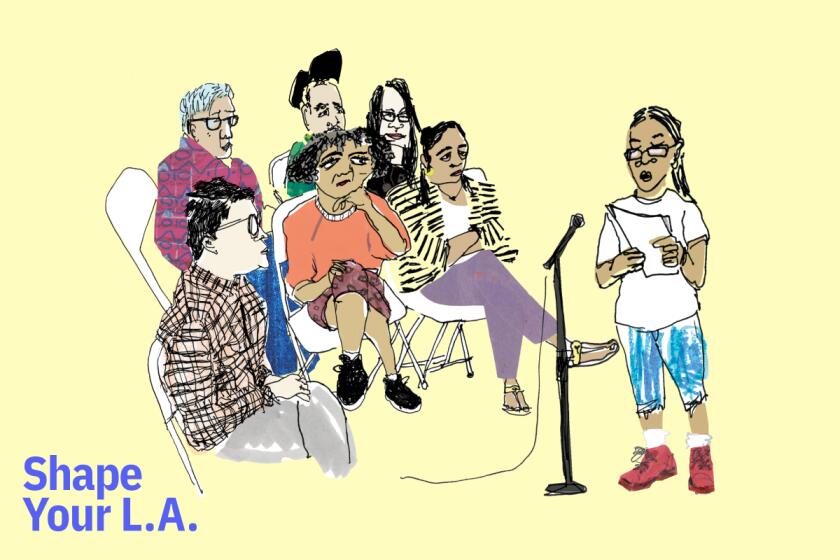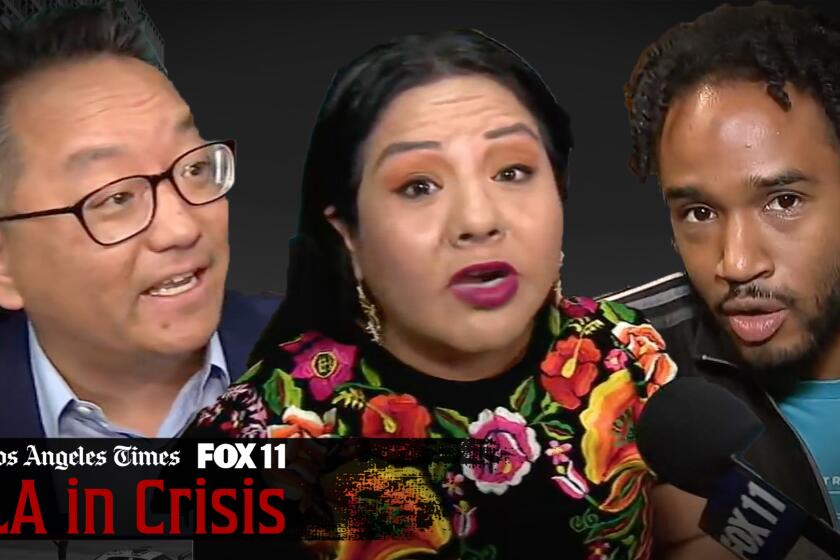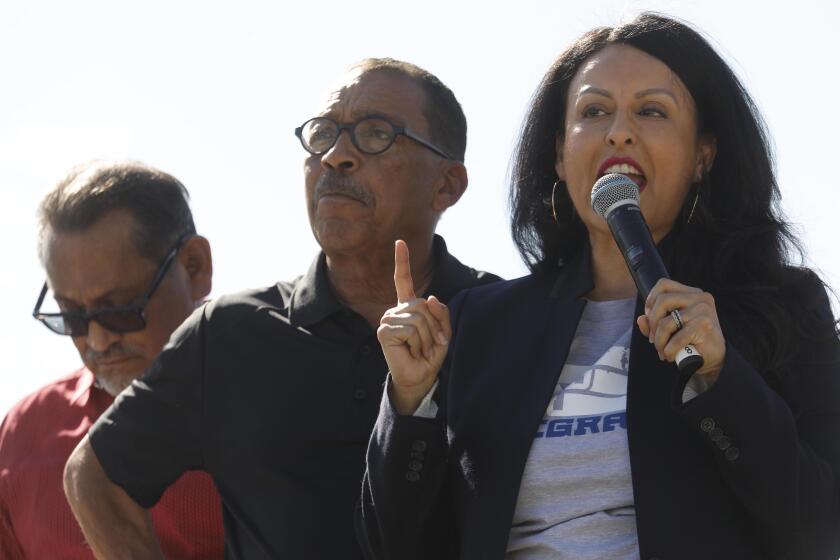L.A. has city and county governments. Why both?

As the cloud of scandal lingers over the Los Angeles City Council, some Angelenos may be wondering what’s the point in having the 15-member panel. After all, L.A. has a mayor who directs the city’s agencies and services, along with a police commission that oversees the Los Angeles Police Department. City residents also have a county government that’s responsible for a wide range of services, plus a school board and a community college board.
Zócalo Public Square, a nonprofit publisher and events organizer, is raising the question directly in a panel discussion Nov. 3 co-hosted by KCRW titled, “Do We Even Need a City Council?”
In truth, California spreads power around multiple local governing bodies, including city councils, county boards of supervisors and special district boards for mosquito control, libraries and even cemeteries.
“California is great at creating overlapping jurisdiction and overlapping jurisdictional responsibility,” said Jim Brulte, a former state lawmaker and Republican Party chair who is now a political consultant.
It’s a feature, not a bug, that reflected concerns at the turn of the 20th century about concentrated power — especially among big-city mayors and political machines on the East Coast and in the Midwest, said Raphael Sonenshein, executive director of the Pat Brown Institute for Public Affairs at Cal State L.A. With party bosses taking over cities and engaging in patronage and other corrupt practices, Sonenshein said, “having dispersed power was not a bad idea.”
The real problem today isn’t corruption, he said, although that is still an issue. Instead, “the problem is the difficulty coordinating divergent governments on issues that cross boundaries.” For example, Sonenshein said, voters keep telling elected officials that homelessness is their top issue. But when they vote for city, county and school board candidates, he said, they have to hope those officials will all find their way into a room to make sure the problem gets addressed.
To help you sort out the roles of the various players in local government, here’s a breakdown of what city and county governments and their top officials do — where they have unique roles, where they share responsibilities, and where the money comes from to pay for them.
Learn who to talk to in government when you want to get things done in your neighborhood. Get involved in your L.A. County community with the help of our people’s guide to power.
What does city government do?
A good way to think about this layer of government is to understand why cities came into being in the first place.
Sonenshein said counties are a “very old form of government,” while many of the cities in Southern California “grew through a movement to incorporate cities and control land use.” And in some places, he said, a key motive for gaining that control was to be able to exclude people from certain properties.
Miguel Santana, chief executive of the Weingart Foundation, put a finer point on it. “Los Angeles grew up under redlining, and it was the law of the land,” said Santana, a former top L.A. city official and aide to a county supervisor. “It was understood as normal and accepted as the way to intentionally segregate communities,” whether by excluding certain groups or by isolating them in the most polluted, least desirable parts of town.
Ironically, he said, “there was this idea that L.A. was going to be the counter to East Coast cities or Midwest cities” that were seen as gritty, dense, packed with immigrants and corrupt.
To that end, the city’s government “was formed around the idea that L.A. should be intentionally designed to dilute authority and give ‘power to the people’ by having a mayor that doesn’t reflect the power that you see in the New York City mayor,” Santana said. That meant governing systems that run relatively independent of politics — the city’s elections are, technically, nonpartisan — and that rely on a professional class of civil servants.
One other reason communities have incorporated is to capture businesses that generate a lot of sales taxes, a portion of which flow into city coffers, said Tom Hogen-Esch, chair of the political science department at Cal State Northridge. For example, he pointed to Cerritos, where auto dealerships and other retailers provide the sales taxes that make up about a third of the city’s budget.
Within Los Angeles’ borders, city agencies provide power and water, oversee trash collection, provide police and fire services, enforce building codes and zoning regulations, repair streets, clean and recycle wastewater, shelter stray animals, run intracity bus lines, operate a zoo and a library system, host conventions, and provide parks, golf courses and recreation programs.
Almost all of those agencies are under the mayor’s direct control, as the vast majority of the city’s department heads report to that office. (One notable exception is the police chief, who is appointed by the mayor with the approval of the City Council and the Police Commission, but who is overseen by the commission — whose five members are appointed by the mayor and confirmed by the council.)
“So if the mayor has an agenda, has a point of view, has specific goals that he or she intends to pursue, they can exercise their authority to get those things done,” Santana said. “So I believe that the mayor does have significant authority.
“Where the council has authority, it’s to the extent that the departments give the council deference in the same way that they give the mayor,” he said. “And you’re seeing the consequences of how dysfunctional that is in the way we handle homelessness,” with each council member deciding on how deal with the situation on his or her turf. “There is no citywide strategy on homelessness; there are 15 strategies,” he said. “It’s not only highly inefficient, it’s highly ineffective.”
(The city and county formed a joint agency, the Los Angeles Homeless Services Authority, in 1993 to coordinate housing and social services for homeless residents. But the agency has limited powers and a limited mission.)
Similarly, land-use decisions flow through the City Council, which adopts the city’s general plan and more specific community plans, then determines if and when proposed developments can depart from those plans. Although it’s not a formal rule, the full council typically defers to the wishes of the individual council member representing the district where a project is proposed.
That deference has led to complaints like the one two Black developers made recently about Councilman Kevin de León, whom they accused of bottling up their project on racial grounds. De León’s staff denied it and said the developers were just trying to squeeze better terms out of the city.
In recent years, Sonenshein said, the state Legislature has started reining in local control over land use in the hope of easing the painful shortage of housing. The state hasn’t reached the point of dictating building codes or deciding which projects get sited where, he said, but it has adopted guidelines that enable more and denser housing construction.
Council members exert a lot of influence over how city services are delivered within their districts, Santana said, ranging from such routine matters as street paving and tree trimming to major economic development projects. Members also have discretionary budgets to spend on the projects or services of their choice.
The mayor, the council and city agencies are all advised by the elected city attorney, whose office also prosecutes misdemeanor criminal offenses and infractions within the city’s borders, and who brings lawsuits on behalf of the city and its residents. And the spending and activities of L.A. city government agencies and officials are audited by the elected city controller, the city’s chief accounting officer.
Residents of Los Angeles demanded resignations from Councilmembers Gil Cedillo and Kevin de León, who haven’t stepped down after the leaked racist recording. But many remained hopeful.
What does county government do?
Like cities and other units of local government, counties are subdivisions of the state of California. But as Brulte put it, “Cities are born whole. When a city is born, it has all of the authority that it needs to do basically whatever it wants.” Counties don’t have that kind of power, Brulte said; instead, they “implement a lot of the business of the state.”
That typically means providing services that work best on a regional basis. The L.A. County Department of Public Social Services lists seven main categories of offerings on its website, including welfare, food and nutrition, job and mental health services, along with specialized services for elderly and disabled residents. “The county manages 99% of all the services that are intended to support people in need,” Santana said.
The county also plays a vital role in healthcare, overseeing Medi-Cal for low-income county residents and operating the county hospital system. “If I get hit by a car in downtown Los Angeles,” Santana said, “I will likely end up at a county hospital for my trauma care. If I’m a burn victim, that’s the likely place where I’m going to end up, regardless of my ability to pay.”
More than half of the funding for these services comes from federal and state taxpayers, according to the Institute for Local Government, although the county also receives a portion of the property and sales taxes assessed within its borders.
“Think about counties as being connected to the state government by an umbilical cord,” Hogan-Esch said. “Through that umbilical cord flows things like money, but also requirements, and limitations and regulations.”
The county also operates cultural institutions — think museums, libraries and concert halls — as well as parks and recreation facilities. And it runs the jails, which will hold you while you’re awaiting trial or if you’re convicted of a misdemeanor or “non-serious, nonviolent, non-sexual” felony. (The Superior Courts in the county are overseen by the state Judicial Council.)
According to the California Institute for Local Government, the state Constitution gives counties and cities the same power to “make and enforce within their limits all local, police, sanitary and other ordinances and regulations not in conflict with general laws.” But counties use that authority, the institute said, only in the areas that are “unincorporated” — that is, not part of a city.
(In fact, in unincorporated areas, county government provides services similar to a city government, including building permits, trash collection and wastewater treatment. Santana said about 1 million people live in unincorporated areas, which is more than in any L.A. County city other than Los Angeles.)
SHAPE YOUR L.A.
Want to get involved?
Interested in having a say in local issues — on your block and beyond? The Times built Shape Your L.A. for you. It’s a tool that walks you through how to navigate civic life and use your power.
The constitution also gives both cities and counties the green light to operate power, water, transportation and telecommunications services. The city of Los Angeles operates its own water and power utility and occasionally floats plans for a municipal wireless broadband network; the county leaves those matters to private companies and local water agencies. The city and the county join the 87 other cities in L.A. County to run the regional mass transit service, the Metropolitan Transportation Authority.
All told, the reach of county government is vast, although less visible to Angelenos than the city bureaucracy. Here’s an example of its role in daily life: “The next time you buy something at a grocery store or put in gas, it’s the county making sure that the price of the item is the price that’s charged when you buy it,” Santana said, citing the county’s Weights and Measures Bureau.
Not surprisingly, L.A. County’s government is the largest local government in the country, in terms of budget, services and personnel, Santana said. And it takes only three people — a majority on the county’s five-member Board of Supervisors — to determine the direction taken for that entire machine.
An independent commission divides the county every 10 years into five districts, each of which elects one supervisor. The board is a hybrid of executive and legislative roles — like mayors, the supervisors oversee the county departments and services in their districts, but like council members they vote on laws and policies that apply to county residents. And like council members, they each have discretionary funds to dole out for projects and services in their districts.
Supervisors can propose sales taxes, parcel taxes, special taxes (for flood control, sanitation or other specific services), occupancy taxes (on hotels) and utility taxes within the limits set by state law, but none of these can go into effect unless voters approve them. Typically, the taxes are imposed in a way that avoids duplicating similar city taxes.
The supervisors have only limited authority over public safety. They decide how much to invest in law enforcement and jails, but the independently elected sheriff doesn’t answer to them — a point the current sheriff, Alex Villanueva, has demonstrated numerous times. (Supervisors’ power could increase if voters pass Measure A, which would allow them to remove an elected sheriff.)
The county’s elected district attorney, who prosecutes suspects and brings lawsuits on behalf of county residents, isn’t answerable to the supervisors either. In fact, the board has its own law firm — the county counsel, which employs more than 300 lawyers — to advise and represent it on legal issues.
While Los Angeles leaders grapple with the fallout from a leaked City Council audio scandal, much can be learned from the council’s unique history.
What do special districts do?
While Los Angeles’ city and county governments are all-purpose creatures, a number of communities in the county are also served by special districts with their own governing boards. These districts exist to fund and deliver a specific service or a small suite of services. Examples include districts that provide mosquito control, water, libraries and even cemeteries.
The focus and specialization of these districts enables them to take a long-term, sustainable approach, said Kyle Packham, advocacy and public affairs director for the California Special Districts Assn. Compared with the larger bureaucracy of a city or county government, he said, a special district is less likely “to get distracted by the popular political issue of the day.”
Publicly owned and governed, special districts can be formed by the Legislature directly or through a petition to the county’s Local Agency Formation Commission, which will study the feasibility of the proposal before giving voters the chance to approve or reject it, Packham said. That vote would typically also elect a governing board for the district.
For funding, some districts rely on parcel taxes, special taxes or general obligation bonds, any of which would require a two-thirds vote by the public to be approved, Packham said. Others rely on revenue from the services they sell; the public doesn’t vote on these rates and fees, but it can seek changes through a protest process, he said.
About The Times Utility Journalism Team
This article is from The Times’ Utility Journalism Team. Our mission is to be essential to the lives of Southern Californians by publishing information that solves problems, answers questions and helps with decision making. We serve audiences in and around Los Angeles — including current Times subscribers and diverse communities that haven’t historically had their needs met by our coverage.
How can we be useful to you and your community? Email utility (at) latimes.com or one of our journalists: Jon Healey, Ada Tseng, Jessica Roy and Karen Garcia.
More to Read
Sign up for Essential California
The most important California stories and recommendations in your inbox every morning.
You may occasionally receive promotional content from the Los Angeles Times.















